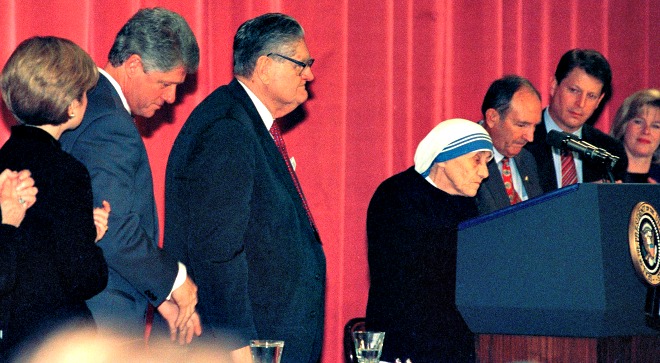Blog Post
How Roe v. Wade triggered America’s civil war over abortion–and Mother Teresa predicted it
By Jonathon Van Maren
It is impossible to overstate the poisonous impact of Roe v. Wade, and there is almost no facet of American life left untouched by the shock and aftershocks of the decision made by nine black-robed men on January 22, 1973. Roe v. Wade has transformed America, and its ongoing legacy is a deep, bloody scar in the American psyche. For these wounds to begin to heal, Roe must be overturned. A brief accounting of the casualties of this decision over the past half-century make this conclusion inescapable.
There are the unnamed dead—thus far, at least sixty million of them. The numbers are difficult to actually grasp, especially when one attempts to imagine the missing millions as people, tiny girls and boys who were briefly here, physically present in America—before being suctioned, suffocated, pulverized, poisoned, dismembered, or decapitated for the crime of inconvenience. Roe is the mother of multitudes of miseries and millions of dead children.
A couple of years ago at a conference hosted by Protect Life Michigan, I was speaking on why men should join the pro-life movement. One of the other speakers was my friend Dr. Monica Miller from Citizens for a Pro-Life Society. During a panel on abortion victim photography, someone asked us for a question we could ask that would highlight the magnitude of what abortion has cost us. Monica paused for a moment. Then she responded. “Where do you put sixty-five million bodies?”
That question crystallizes everything. Abortion isn’t about reproductive rights. It isn’t about healthcare. It is about people. Those people have bodies. And those bodies go somewhere after they have been suctioned into bloody slurry. Where do they go? Philosophers have asked through the ages: Where do we go after we die? With abortion, the question we need to ask is similar: Where do they go after we kill them?
Monica Miller knows of what she speaks. The first chapter of her magnificent memoir Abandoned: The Untold Story of the Abortion Wars is titled, simply, “Bodies.” She describes going through a dumpster in an alley behind an abortion clinic, retrieving garbage bags. And she describes what they found:
The bag was stuffed with an unrecognizable material … I turned it over in my hands, trying to make sense of it. At last my eyes recognized a shape crammed tightly against the plastic. It jumped out at me — an arm, disconnected from anything else that would have helped me see it for what it was. And then my eyes distinguished another arm, and then a severed foot, a full inch in length.
I had been staring at arms but did not see arms. I had no prior context by which my brain could recognize them. They were the dismembered limbs of a completely torn and mutilated body and, up until that day, my eyes had never been confronted with such a reality. It was as if an alien word had been spoken, a word I could not at first fully understand until, after much straining, I finally comprehended the message. Someone was trying to speak to me through the silent, shocking vestige of this broken body.
The baby was a little boy. After reassembling him, Miller began to photograph him. The pro-life activist with her, Joe Scheidler, couldn’t watch long. “I can’t look at him anymore.” He was, Miller wrote, “a hideous parody of a living baby.” Over the years, Miller would take thousands of these photographs of the babies she retrieved from dumpsters. Even the New York Times would run a series of her photos. Through Miller’s work, these voiceless victims speak from the dumpsters and the trash cans.
Joe Scheidler, the “Godfather of Direct Pro-Life Action,” described the same scene in his 2016 memoir Racketeer for Life. After going through the dumpsters, he wrote, the garbage bags of babies were taken to his garage. There was a clear bag full of fluid in one of them:
Monica picked it up and looked through the fluid. Then she shifted the bag, and a severed arm appeared. It was a baby boy of at least six months gestation, cut to pieces by the abortionist. We took him and laid out his broken body on a paper towel.
The chapter describing that scene is titled “To Bury the Dead.” But before the children were laid to rest, Scheidler, Miller and other pro-lifers did something extraordinary. On May 6, 1987, they carried the aborted children by hearse to the front of the abortion clinic where they had been killed. They laid the babies tenderly on long tables, and held a press conference. The pro-abortion press erupted. Not because the babies had been killed, of course. But because they had been seen. They had, in some strange way, escaped from the trash to tell their stories.
I know many pro-life activists who have come face to face with the aborted dead. They often look haunted when they talk about it. There is something strange and insane about having seen the bodies of murdered children that were murdered legally. It is even stranger to have held babies that abortion activists insist are not babies. The abortion industry essentially survives by gaslighting the public. We tell them what we have seen, and they swear it isn’t true; that we haven’t seen what we’ve seen. Who are you going to believe, us or your lying eyes?
It is a sad irony that many abortion activists and feminists believed that Roe v. Wade was an end to cultural conflict rather than a beginning. The leaders of the women’s movement’s second wave were persuaded to champion feticide as a fundamental prerequisite of female liberation by men such as Larry Ladler and Bernard Nathanson of the National Association for the Repeal of Abortion Laws (now NARAL Pro-Choice America). Nathanson, who later became pro-life, tells that story in his mauling memoir The Hand of God, as does Sue Ellen Browder in her revealing book Subverted: How I Helped the Sexual Revolution Hijack the Women’s Movement.
In the decades to come, a women’s movement once dedicated to advancing women worked to persuade America that these advances could only come over the corpses of their children.
This conflict has been a civil war in every sense: Between the pro-life activists and abortion activists; between increasingly polarized political factions; between family members, fathers, mothers, and, most tragically, between mothers and their children. The violence of abortion is a savage intimacy, as the pro-choice ideology promoted by the press, pop culture, Hollywood, and progressive politicians posits that the interests of mothers are often inherently at odds with those of their pre-born children. This has culminated in a fervent and groundless faith among the devotees of Roe that human life in the early stages of development is worthless. The bloodshed has made us coldblooded, and the bonds of our families and our polity have ruptured under the weight of tiny corpses.
After Roe, abortion was first defended as a necessary evil. President Bill Clinton, twisting about for an appropriately propagandistic phrase that would allow him to support abortion while appearing hesitant, hit political paydirt with his insistence that feticide should be “safe, legal, and rare,” an iteration that inherently assumed the worthlessness of the pre-born child, who cannot be “safely” aborted. But if abortion is a tool of female liberation, such provisos could not be tolerated for long. The pro-choice movement launched “Shout Your Abortion” campaigns; published stories about “happy abortions”; and finally, declared abortion to be a social good. At the Women’s March the day after President Donald Trump’s Inauguration, America’s largest abortion provider Planned Parenthood received rousing cheers from the crowd, and one speaker wore a t-shirt with covered with the phrase “I heart abortion.”
As the battle over Roe intensifies, abortions are now celebrated. At the Democratic Convention in 2016, Ilyse Hogue of NARAL Pro-Choice America took the stage and announced that she’d had an abortion, receiving applause and cheers in response. In 2020, actress Michelle Williams hoisted her trophy at the Golden Globes award and told the crowd that but for her ability to abort her child, she could never have achieved this honor. It was a blunt and brutal admission of what abortion so often is: the sacrifice of a child for self-interest. The blood of Williams’ pre-born son or daughter had greased the skids for her Hollywood success, and that was justification enough. Such is the fruit of Roe v. Wade.
It must be mentioned, as well, that Roe—along with the Sexual Revolution—has poisoned our attitudes towards sex. The history of abortion in America has not been the history of female liberation, but the history of American misogyny, enabling men to abandon women with callousness, to reject their responsibilities, and even to ensure that sexual assault could be easily covered up. Abortion allowed men and women to use one another, with abortion as the backstop when pharmaceuticals and rubbers failed to prevent the arrival of a child.
It was abortion that allowed men to see the presence of a child—their child—as “her problem.” Pregnant women, after all, could have it—the baby—“taken care of.” Frederica Matthewes-Green famously observed that: “No woman wants an abortion like she wants an ice cream cone or a Porsche. She wants an abortion like an animal caught in a trap wants to gnaw off its own leg.” The availability of abortion encouraged men to tell women they had impregnated to start chewing—and then walk away.
And there can be little doubt that Roe v. Wade utterly transformed American politics. When the Supreme Court justices imposed their sweeping diktat on a divided nation from on high, abortion was illegal in thirty states and legal in only some circumstances in the remaining twenty. Roe struck the nation like lightning; the inevitable thunder has crashed, echoed, and re-echoed ever since. The ruling spawned and then solidified a conservative backlash; and caused entire states to flip from blue to red as the Democrats embraced abortion extremism and formerly pro-life politicians (such as Joe Biden, Al Gore, and Jesse Jackson) abandoned their convictions for political expedience.
The Roe decision ensured that the Supreme Court has become a focal flashpoint for decades. Democrats frequently claim that the GOP engaged in “court-packing” by ensuring that Neil Gorsuch, Brett Kavanaugh, and Amy Coney Barrett ended up on the Court during the Trump Administration. The truth is that the Republicans were late to the game. In 1987, Senator Ted Kennedy fired the first salvo in the Court wars, launching a brutal attack on renowned conservative jurist Robert Bork, an anti-abortion Reagan appointee.
“Robert Bork’s America is a land in which women would be forced into back-alley abortions, blacks would sit at segregated lunch counters, rogue police could break down citizens’ doors in midnight raids, and schoolchildren could not be taught about evolution,” Kennedy intoned. Joe Biden, the head of the Senate Judiciary Committee, suspended his scandal-plagued presidential campaign in part to ensure Bork’s defeat. Bork’s nomination was rejected, and Reagan instead put forward Anthony Kennedy, who would vote to uphold Roe’s “essential holding” in Planned Parenthood v. Casey in 1992. The vote was 5-4. Kennedy was correct: If Bork had been on the Court, America would be a different country today.
The tactic was so effective that the Democrats decided to try it again. When President George H.W. Bush nominated Clarence Thomas to the Court in 1991, activist lawyer Florence Kennedy made an announcement at a New York conference of the National Organization for Women: “We’re going to ‘bork’ him.” Like clockwork, Thomas was accused of sexual impropriety—and it nearly derailed his nomination. President Bush stood by him, and as Joe Biden presided, Thomas responded furiously to the accusations:
This is a circus. It’s a national disgrace. And from my standpoint, as a black American, it is a high-tech lynching for uppity blacks who in any way deign to think for themselves, to do for themselves, to have different ideas, and it is a message that unless you kowtow to an old order, this is what will happen to you. You will be lynched, destroyed, caricatured by a committee of the U.S. Senate rather than hung from a tree.
Thomas, unlike Bork survived the Democratic gauntlet and took his seat on the Supreme Court, becoming one of the few reliable anti-Roe votes. Bush’s previous nominee, David Souter, was chosen specifically because he had no “paper trail” and could not be targeted the way Bork had been. Souter turned out to be a reliable liberal and voted to uphold Roe in Planned Parenthood v. Casey. Joe Biden, who had been persuaded to vote for Souter by a pro-choice GOP Senator Warren Rudman, who assured him that Souter was pro-Roe, was so overcome with joy when he heard the news that when he spotted Rudman at the Amtrak station in Wilmington Delaware, he dashed across the platform and swept Rudman up in a hug. According to Rudman’s 1996 memoir Combat: Twelve Years in the U.S. Senate, the two men wept for joy. Roe v. Wade was safe.
Unlike the Democrats and unfortunately for the pro-life movement, the Republicans lagged in following suit and applying an abortion litmus test to Supreme Court nominees. Until quite recently, in fact, only the Democrats were playing the game while the gentlemanly GOP fastidiously observed norms long abandoned by their pro-abortion ideological opponents. In 1993, Ruth Bader Ginsburg, nominated by Bill Clinton, did something no Supreme Court nominee had ever done: She openly endorsed legal abortion. “It is essential to women’s equality with man that she be the decisionmaker, that her choice be controlling,” she told the Senate Judiciary Committee. “If you impose restraints that impede her choice, you are disadvantaging her because of her sex.”
Had such an unambiguously pro-life statement been made to the Committee, the hapless nominee would have undoubtedly suffered the same treatment as Robert Bork and Clarence Thomas. The Republicans, however, lavished the undeniably brilliant Ginsburg with praise and joined their Democratic colleagues in sending her off to the bench. Ginsburg was confirmed 93-3. Bill Clinton’s second pro-abortion pick for the Supreme Court, Stephen Breyer, was confirmed by a vote of 87-9. Sonia Sotomayor, Obama’s first pro-abortion nominee, was confirmed 68-31; Elena Kagan was confirmed 63-37. In short: The Democrats have long recognized that the Court is an essential tool in the fight for legal abortion and have acted accordingly. The GOP, a few short years after Bork and the attempted borking of Thomas, were sending Clinton’s nominees sailing through to the bench.
Not until 2018, when Brett Kavanaugh faced the same vicious tactics as Clarence Thomas, did the GOP truly begin to fight back, as top Democrats leveled vile and egregious accusations against Kavanaugh. Kavanaugh became the victim of a search-and-destroy mission designed to preserve Roe v. Wade, poised as he was to become the first conservative justice to replace a “swing” vote—Anthony Kennedy, who reliably voted to uphold Roe. Kavanaugh was accused, among other crimes, of gang-rape, and the media ran with every accusation they could get their hands on. Finally furious, the GOP fought back, Kavanaugh was confirmed, and the spectacle of the televised smear job and the caterwauling pro-abortion protestors pounding on the Supreme Court doors outside damaged the Democrats so badly that when President Donald Trump nominated Amy Coney Barrett to replace Ruth Bader Ginsburg in 2020, they treated her with kid gloves.
Almost immediately, they began to claim that the Republicans had been playing politics with the Court for decades—and that it was time to pack the Court with additional justices to dilute the potentially pro-life rulings that might be handed down by the current conservative majority. For the Democrats, Roe v. Wade must be protected at all costs. If they lose the game, they will simply try to change the rules. Roe is a hill made of millions of baby corpses, and while they may not choose to die on it, they will certainly kill for it. The Democrats are livid that the one-sided game they have been playing has been joined: The fact that Ginsburg openly proclaimed her views on abortion while Amy Coney Barrett fastidiously avoided discussing hers illustrated clearly that the double standard continues.
The war over the Supreme Court is now one of the primary political drivers in the United States. Hundreds of millions of dollars have been poured into political campaigns for the sole purpose of electing legislators who will vote for the right justices—that is, justices who will either uphold or overturn Roe. Many believe that Donald Trump narrowly won the presidency in 2016 because he provided a list of potential Supreme Court nominees to calm the nerves of skittish conservatives nervous about his previously pro-Roe record. Trump himself knew that the Supreme Court vacancy left by Antonin Scalia’s death (and held open by an iron-willed Mitch McConnell) was a political gift, openly boasting at rallies that even those who hated him would vote for him because of the Supreme Court. Presidential elections are now defined and even decided by the potential for appointing justices.
Many on both the Left and the Right have opined on the unhealthy fixation millions of Americans have with the Supreme Court, and the late Justice Antonin Scalia himself observed with concern the Court’s growing prominence. But that fixation is due, in large part, to Roe v. Wade. The Court forced a radical abortion regime on states with solid pro-life majorities: Abortion must remain legal in New York as well as Texas; in Alabama as well as California. A handful of unelected lawyers forced millions of Americans to adopt a status quo that they found—and find—to be morally reprehensible and wicked, and nothing has been the same ever since.
With a conservative majority finally in place on the Supreme Court—although, as past GOP appointees have illustrated, this may not be an indication of how the justices will actually vote—many progressives are now predicting that the end of Roe is finally near. The End of Roe v. Wade, in fact, is the title of a book by abortion activists Robin Mary and Jessica Pieklo. In response, states like New York, New Jersey, Massachusetts and others are passing extreme pro-abortion legislation enshrining and expanding the right to feticide, while pro-life states are passing trigger laws that will ban abortion the moment Roe falls. Prominent Democrats, led by Joe Biden, are promising to enshrine Roe in statute if that finally happens.
The hard truth is that on abortion, unity is impossible. Those of us who recognize the humanity of pre-born children in the womb and see their cruel destruction as morally abhorrent can never be united with those who believe that killing children in the womb is a fundamental right and the key to social liberation. A half-century of abortion wars should by now have made it crystal clear that if the American republic is to survive, overturning Roe is an essential first step. There is much talk on both Left and Right about “turning down the temperature” and reducing polarization. Removing the abortion wars from the nation’s capital to the nation’s capitols would be an enormous step forward.
With Roe gone, those states that wish to be abortion-free could pass laws ensuring protections for pre-born children, while those who wish to preserve these barbaric practices could pass their own laws. Those who wish to live in a pro-life state could do so; those who wish to live in a pro-abortion state would also have plenty of options. Both the abortion movement and the pro-life movement would, of course, continue to be active in federal politics. But the key, consequential fights would take place on the state level, where legislators sent to do the people’s business could be kept accountable more locally and voters could decide directly what sort of state they want to live in. New Yorkers could decide for their state; Mississippians could determine their own path, and the Supreme Court and the presidency could finally become significantly less relevant to the abortion wars. This would this bring down the temperature nationally as the efforts of activists are redirected inwards.
To be sure, this would be an uneasy truce among those with radically differing values, and there are those who might find it dramatic to say that Roe is ripping the American republic apart. But there is another aspect to all of this that has heightened the drama of American politics: Violence begets violence. A nation that has destroyed more than sixty million tiny children cannot expect everything to proceed peacefully while the subterranean sewers run red with blood. As one writer noted on social media, you cannot have war in the womb and peace on the streets. Religious leaders have often noted that God’s judgment on a culture that has killed so many millions is inevitable, and one wonders if the judgement is already here, as abortion does not only shred babies—it is shredding the American polity. The abortion wars themselves have become, in some ways, a judgement.
A culture that has succumbed to the lethal temptation of sacrificing God’s most precious gifts in exchange for consequence-free carnal pleasures is a culture with a death wish — and we may well be seeing the throes of a dying society.
Mother Teresa once predicted this at the National Prayer Breakfast in Washington, D.C. on February 3, 1994. She had long harbored a secret hope that she could persuade Hillary Clinton to see the light and come out for the pro-life cause, and the title of her speech was “Whatever You Did Unto One of the Least, You Did Unto Me.” As the assembled crowd—including Bill and Hillary Clinton—grew increasingly silent and uncomfortable, the tiny nun talked about how John the Baptist had leapt in the womb in the presence of the unborn Savior; and of the selfishness that was eroding love for children in the womb. And then she said this:
By abortion, the mother does not learn to love, but kills even her own child to solve her problems. [Abortion is] really a war against the child, and I hate the killing of the innocent child, murder by the mother herself. And if we accept that the mother can kill even her own child, how can we tell other people not to kill one another? … Any country that accepts abortion is not teaching its people to love one another, but to use violence to get what they want. This is why the greatest destroyer of love and peace is abortion.
The stunned silence was smashed by thunderous applause, a standing ovation that lasted five or six minutes. Not all rose, and not all clapped; Bill and Hillary Clinton and Vice President Al Gore and his wife Tipper sat frozen in place. One wonders if, deep down, they knew that she was right; if they had to struggle to quell their consciences; if they internally cursed her gently-spoken but razor-sharp rebuke. America’s peace and prosperity are a false peace and her prosperity denied to millions of murdered children, but the Clintons and the Gores could not face this awful truth.
To survive, America must face this reality. If not, as Mother Teresa predicted and as the intervening years have proven, violence may continue to spill from the operating table into the streets. Roe must die so that America—and her children—may live.









Another excellent piece, Jonathon. I wish the Supreme Court would take the unlikely–and very courageous–stance that the unborn child is a person protectable under the Constitution. Then no state could pass pro-abortion legislation. But that’s not going to happen, unfortunately.